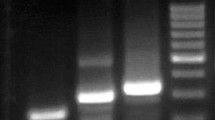Abstract
Background
Warfarin has a narrow therapeutic range and wide inter-individual dosing requirements that may be related to functional variants of genes affecting warfarin metabolism (i.e., CYP2C9) and activity (i.e., vitamin K epoxide reductase complex subunit 1-VKORC1). We hypothesized that variants in these two genes explain a substantial proportion of variability in stable warfarin dose and could be used as a basis for improved dosing algorithms.
Methods
Consecutive consenting outpatients (n = 213) with stable INR (2–3) for >1 month were enrolled. Buccal DNA was extracted using a Qiagen mini-column and CYP2C9*2 and VKORC1 genotyping performed by the Taqman 3′ nuclease assay. Sequencing for CYP2C9*3, genotyping was done using Big Dye v3.1 terminator chemistry Dose by genotype was assessed by linear regression.
Results
Weekly warfarin dose averaged 30.8 ± 13.9 mg/week; average INR was 2.42 ± 0.72. CYP2C9*2/*3 genotype distribution was: CC/AA (wild-type [WT]) = 71.4%, CT/AA = 18.3%, CC/AC = 9.4%, and CT/AC = 1%; VKORC1 genotypes were CC (WT) = 36.6%, CT = 50.7%, and TT = 12.7%. Warfarin doses (mg/week) varied by genotype: for CYP2C9, 33.3 mg/week for WT (CC/AA), 27.2 mg/week for CT/AA (P = 0.04 vs. WT), 23.0 mg/week for CC/AC (P = 0.003), and 6.0 mg/week for CT/AC (P < 0.001), representing dose reductions of 18–31% for single and 82% for double variant carriers; for VKORC1: 38.4 mg/week for WT (CC), 28.6 mg/week for CT (P < 0.001 vs. WT), 20.95 mg/week for TT (P < 0.001). In multiple linear regression, genotype was the dominant predictor of warfarin dose (P = 2.4 × 10−15); weak predictors were age, weight, and sex. Genotype-based modeling explained 33% of dose-variance, compared with 12% for clinical variables alone.
Conclusion
In this large prospective study of warfarin genetic dose-determinants, carriage of a single or double CYP2C9 variant, reduced warfarin dose 18–72%, and of a VKORC1 variant by 65%. Genotype-based modeling explained almost one-half of dose-variance. A quantitative dosing algorithm incorporating genotypes for 2C9 and VKORC1 could substantially improve initial warfarin dose-selection and reduce related complications.


Similar content being viewed by others
References
Weiss P, Halkin H, Almog S (1986) The negative impact of biological variation in the effect and clearance of warfarin on methods for prediction of dose requirements. Thromb Haemost 56(3):371–375
Carlquist JF, Anderson JL (2004) Pharmacogenomics in cardiovascular medicine. Drug Develop Res 62:180–190
Bachmann K (2002) Genotyping and phenotyping the cytochrome p-450 enzymes. Am J Ther 9(4):309–316
Rettie AE, Wienkers LC, Gonzalez FJ, Trager WF, Korzekwa KR (1994) Impaired (S)-warfarin metabolism catalysed by the R144C allelic variant of CYP2C9. Pharmacogenetics 4(1):39–42
Furuya H, Fernandez-Salguero P, Gregory W, Taber H, Steward A, Gonzalez FJ, Idle JR (1995) Genetic polymorphism of CYP2C9 and its effect on warfarin maintenance dose requirement in patients undergoing anticoagulation therapy. Pharmacogenetics 5(6):389–392
Stubbins MJ, Harries LW, Smith G, Tarbit MH, Wolf CR (1996) Genetic analysis of the human cytochrome P450 CYP2C9 locus. Pharmacogenetics 6(5):429–439
Yasar U, Eliasson E, Dahl ML, Johansson I, Ingelman-Sundberg M, Sjoqvist F (1999) Validation of methods for CYP2C9 genotyping: frequencies of mutant alleles in a Swedish population. Biochem Biophys Res Commun 254(3):628–631
Crespi CL, Miller VP (1997) The R144C change in the CYP2C9*2 allele alters interaction of the cytochrome P450 with NADPH: cytochrome P450 oxidoreductase. Pharmacogenetics. 7(3):203–210
Takanashi K, Tainaka H, Kobayashi K, Yasumori T, Hosakawa M, Chiba K (2000) CYP2C9 Ile359 and Leu359 variants: enzyme kinetic study with seven substrates. Pharmacogenetics. 10(2):95–104
Aithal GP, Day CP, Kesteven PJ, Daly AK (1999) Association of polymorphisms in the cytochrome P450 CYP2C9 with warfarin dose requirement and risk of bleeding complications. Lancet 353(9154):717–719
Higashi MK, Veenstra DL, Kondo LM, Wittkowsky AK, Srinouanprachanh SL, Farin FM, Rettie AE (2002) Association between CYP2C9 genetic variants and anticoagulation-related outcomes during warfarin therapy. JAMA 287(13):1690–1698
Taube J, Halsall D, Baglin T (2000) Influence of cytochrome P-450 CYP2C9 polymorphisms on warfarin sensitivity and risk of over-anticoagulation in patients on long-term treatment. Blood 96(5):1816–1819
Rieder MJ, Reiner AP, Gage BF, Nickerson DA, Eby CS, McLeod HL, Blough DK, Thummel KE, Veenstra DL, Rettie AE (2005) Effect of VKORC1 haplotypes on transcriptional regulation and warfarin dose. N Engl J Med 352(22):2285–2293
Li T, Chang CY, Jin DY, Lin PJ, Khvorova A, Stafford DW (2004) Identification of the gene for vitamin K epoxide reductase. Nature 427(6974):541–544
D’Andrea G, D’Ambrosio RL, Di Perna P, Chetta M, Santacroce R, Brancaccio V, Grandone E, Margaglione M (2005) A polymorphism in the VKORC1 gene is associated with an interindividual variability in the dose-anticoagulant effect of warfarin. Blood 105(2):645–649
Landefeld CS, Beyth RJ (1993) Anticoagulant-related bleeding: clinical epidemiology, prediction, and prevention. Am J Med 95(3):315–328
Sanderson S, Emery J, Higgins J (2005) CYP2C9 gene variants, drug dose, and bleeding risk in warfarin-treated patients: a HuGEnet systematic review and meta-analysis. Genet Med 7(2):97–104
Hamby L, Weeks WB, Malikowski C (2000) Complications of warfarin therapy: causes, costs, and the role of the anticoagulation clinic. Eff Clin Pract 3(4):179–184
Caro JJ (2004) An economic model of stroke in atrial fibrillation: the cost of suboptimal oral anticoagulation. Am J Manag Care 10(14 Suppl):S451–458
Hull JH, Murray WJ, Brown HS, Williams BO, Chi SL, Koch GG (1978) Potential anticoagulant drug interactions in ambulatory patients. Clin Pharmacol Ther 24(6):644–649
Wadelius M, Sorlin K, Wallerman O, Karlsson J, Yue QY, Magnusson PK, Wadelius C, Melhus H (2004) Warfarin sensitivity related to CYP2C9, CYP3A5, ABCB1 (MDR) and other factors. Pharmacogenomics J 4(1):40–48
Author information
Authors and Affiliations
Corresponding author
Rights and permissions
About this article
Cite this article
Carlquist, J.F., Horne, B.D., Muhlestein, J.B. et al. Genotypes of the cytochrome p450 isoform, CYP2C9, and the vitamin K epoxide reductase complex subunit 1 conjointly determine stable warfarin dose: a prospective study. J Thromb Thrombolysis 22, 191–197 (2006). https://doi.org/10.1007/s11239-006-9030-7
Published:
Issue Date:
DOI: https://doi.org/10.1007/s11239-006-9030-7




